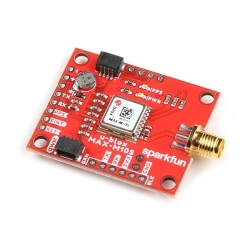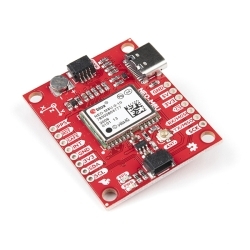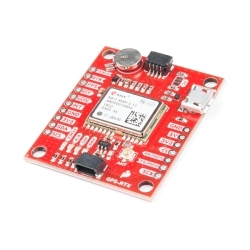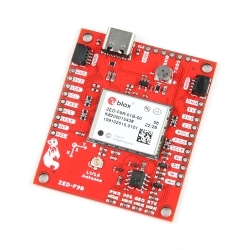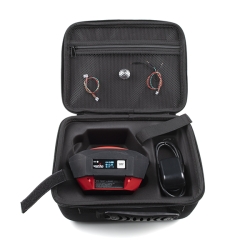GPS/GNSS Buying Guide
There are a lot of options when it comes to GPS and GNSS hardware. The size, update rate, power requirements, these are all features that you'll want to look into before you choose which hardware is right for your project.
GPS/GNSS Boards
GPS Breakout - NEO-M9N - Multiple Options
The SparkFun NEO-M9N GPS Breakout is a high quality GPS board with equally impressive configuration options.
| Start Time | Update Rate | Antenna Options | Dimensions | Protocol | Power Requirements |
|---|---|---|---|---|---|
| Cold: 24 sec, Hot: 2 sec | 25Hz Max (4 concurrent GNSS) | SMA, U.FL, Chip Antenna | 40.64mm x 36.83mm | NMEA, UBX, and RTCM over UART or I2C | 3.3VCC and I/O, ~31mA |
GNSS Receiver Breakout - MAX-M10S (Qwiic)
The SparkFun MAX-M10S Breakout is an ultra-low-power, GNSS board that is perfect for battery operated applications that don't possess a lot of space.
| Start Time | Update Rate | Antenna | Dimensions | Protocol | Power Requirements |
|---|---|---|---|---|---|
| Cold: 24 sec, Hot: 1 sec | 10Hz | SMA | 1.74" x 1.20" | NMEA and UBX protocols over I2C or UART interfaces | 3.3V, Current Consumption: ~6mA to ~25mA |
GPS Breakout - U.FL, ZOE-M8Q (Qwiic)
The SparkFun ZOE-M8Q GPS Breakout is a high accuracy, miniaturized, GPS board that is perfect for applications that don't possess a lot of space.
| Start Time | Update Rate | Antenna | Dimensions | Protocol | Power Requirements |
|---|---|---|---|---|---|
| Cold: 26 sec, Hot: 1 sec | 18Hz | External | 25.25mm x 25.25mm | NMEA, UBX, and 18Hz RTCM | 3.3V, 29mA |
GPS Dead Reckoning Breakout - NEO-M8U (Qwiic)
The SparkFun NEO-M9N GPS Breakout is a high quality GPS board with equally impressive configuration options through Dead Reckoning.
| Start Time | Update Rate | Antenna | Dimensions | Protocol | Power Requirements |
|---|---|---|---|---|---|
| Cold: 26 sec, Hot: 1.5 sec | 30Hz | U.FL connector for use of antenna of your choice | 42mm x 35mm | NMEA, UBX, and RTCM over UART or I2C | 3.3V, 29mA |
GPS Breakout - Chip Antenna, SAM-M8Q (Qwiic)
The SparkFun SAM-M8Q GPS Breakout is a high quality GPS board with equally impressive configuration options.
| Start Time | Update Rate | Antenna | Dimensions | Protocol | Power Requirements |
|---|---|---|---|---|---|
| Cold: 26 sec, Hot: 1 sec | 18Hz | External | 41.35mm x 41.35mm | NMEA, UBX, and 18Hz RTCM | 3.3V, 29mA |
GPS Breakout - Chip Antenna, SAM-M10Q (Qwiic)
The SAM-M10Q includes a built-in chip antenna and is compatible with the L1 band on all five GNSS constellations.
| Start Time | Update Rate | Antenna | Dimensions | Protocol | Power Requirements |
|---|---|---|---|---|---|
| Cold: 23 sec, Hot: 1 sec | 18Hz | Built-in chip antenna | 1.6in x 1.6in | NMEA, UBX | 3.3V |
GPS Breakout - XA1110 (Qwiic)
Equipped with the XA1110 GPS module from GTOP, this board utilizes the MediaTek MT3333 chipset and easy hookup thanks to the 2 onboard Qwiic Connectors.
| Start Time | Update Rate | Antenna | Dimensions | Protocol | Power Requirements |
|---|---|---|---|---|---|
| Cold: 35-60 sec, Hot: 1 sec | Up to 10Hz | External (U.FL) | 1.6in x 1.6in | NMEA | 3.3V, 25 mA |
GNSS L1/L5 Breakout - NEO-F10N, SMA
The SparkFun NEO-F10N GNSS L1/L5 Breakout is a super economical GNSS board with meter-level positional accuracy.
| Start Time | Update Rate | Antenna | Dimensions | Protocol | Power Requirements |
|---|---|---|---|---|---|
| Cold: 28 sec, Hot: 2 sec | 20Hz | SMA | 50.8mm x 38.1mm (w/o SMA connector) | NMEA, UBX over UART | 3.3V, 21mA - 26mA |
High-Precision RTK GNSS Boards
GPS-RTK Breakouts with ublox ZED-F9P Module
The SparkFun GPS-RTK raises the bar for high-precision GPS and is the latest in a line of powerful RTK boards featuring the ZED-F9P module from u-blox.
| Start Time | Update Rate | Antenna | Dimensions | Protocol | Power Requirements |
|---|---|---|---|---|---|
| Cold: 25 sec, Hot: 2 sec | 25Hz | Multiple Options | 43.5mm x 43.2mm | NMEA, UBX | 3.3V, 68mA - 130mA |
GNSS-RTK L1/L5 Breakout - NEO-F9P (Qwiic)
The SparkFun GNSS-RTK L1/L5 Breakout - NEO-F9P (Qwiic) is a high precision GNSS board with equally impressive configuration options.
| Start Time | Update Rate | Antenna | Dimensions | Protocol | Power Requirements |
|---|---|---|---|---|---|
| Cold: 27 sec, Hot: 3 sec | 25Hz | SMA | 1.70" x 1.70" | NMEA, UBX, RTCM, SPARTN, CLAS protocols over UART or I2C interfaces | 3.3V, 95mA - 135mA |
Triband GNSS RTK Breakout - mosaic-X5
The SparkFun mosaic-X5 Triband GNSS RTK Breakout you'll be provided with the easiest way to get started using L1, L2, and L5 GPS bands simultaneously!
| Start Time | Update Rate | Antenna | Dimensions | Protocol | Power Requirements |
|---|---|---|---|---|---|
| Cold: 45 sec, Hot: 1 sec | 100Hz | SMA | 1.70" x 1.70" | NMEA, RINEX, RTCM, CMR, CMR+ | 3.0 to 5.0V, 150mA max current |
Triband GNSS RTK Breakout - UM980
The SparkFun Triband GNSS RTK Breakout features the UM980 GNSS high precision RTK position module from Unicore Communications.
| Start Time | Update Rate | Antenna | Dimensions | Protocol | Power Requirements |
|---|---|---|---|---|---|
| Cold: 30 sec, Hot: 5 sec | 50Hz | SMA | 1.70" x 1.70" | NMEA, RTCM, and Unicore (w/ specific firmware) protocols over UART | 3.3V, 145mA – 180mA |
GPS-RTK Board - NEO-M8P-2
The SparkFun GPS-RTK Board is a powerful breakout for the NEO-M8P-2 module from u-blox. The NEO-M8P-2 is a top-of-the-line module GNSS & GPS solutions!
| Start Time | Update Rate | Antenna | Dimensions | Protocol | Power Requirements |
|---|---|---|---|---|---|
| Cold: 29 sec, Hot: 1 sec | 10Hz | SMA | 40.6mm x 33mm | NMEA and UBX-NAV | ~35mA |
L-Band Correction GNSS Boards
GNSS Combo Breakout - ZED-F9P, NEO-D9S
This versatile combo breakout pairs the u-blox ZED-F9P multi-band high-precision GNSS module with the NEO-D9S L-band GNSS correction data receiver.
ZED-F9P
| Start Time | Update Rate | Antenna | Dimensions | Protocol | Power Requirements |
|---|---|---|---|---|---|
| Cold: 25 sec, Hot: 2 sec | 25Hz | SMA | 1.70" x 2.50" | NMEA, UBX | 3.3V, 68mA - 130mA |
NEO-D9S
| Time to First Frame | User Data Rates | L-Band Reception |
|---|---|---|
| <10s @ 2400bps | 600, 1200, 2400, 4800 baud | 1525 MHz to 1559 MHz |
GNSS Correction Data Receiver - NEO-D9S
The SparkFun NEO-D9S GNSS Correction Data Receiver is a satellite data receiver for L-Band correction broadcast.
| Time to First Frame | User Data Rates | L-Band Reception | Board Dimensions |
|---|---|---|---|
| <10s @ 2400bps | 600, 1200, 2400, 4800 baud | 1525 MHz to 1559 MHz | 1.70" x 1.70" |
Dead Reckoning Boards
GPS-RTK Dead Reckoning Breakout - ZED-F9R
The SparkFun ZED-F9R GPS-RTK is a high-precision Automotive Dead Reckoning board with a built-In accelerometer and gyroscope for velocity and heading accuracy.
| Start Time | Update Rate | Antenna | Dimensions | Protocol | Power Requirements | Velocity Accuracy | Heading Accuracy |
|---|---|---|---|---|---|---|---|
| Cold: 24 sec, Hot: 2 sec | 25Hz | u.FL and SMA options (see below) | 1.7in x 2.0in | NMEA, UBX, and RTCM protocols over UART or I2C interfaces | 3.3V, ~85mA to ~130mA | 0.05m/s | 0.2 degrees |
GPS-RTK Dead Reckoning pHAT for Raspberry Pi
The SparkFun ZED-F9R GPS-RTK pHAT is a high-precision Automotive Dead Reckoning board to be used with a Raspberry Pi.
| Start Time | Update Rate | Antenna | Dimensions | Protocol | Power Requirements | Velocity Accuracy | Heading Accuracy |
|---|---|---|---|---|---|---|---|
| Cold: 24 sec, Hot: 2 sec | 25Hz | u.FL | 2.56in x 2.22in | NMEA, UBX, and RTCM protocols over UART or I2C interfaces | 3.3V, ~85mA to ~130mA | 0.05m/s | 0.2 degrees |
Enclosed RTK Surveyors
SparkFun RTK Facet
With an enclosed L1/L2 antenna, 6Ah LiPo battery, the RTK Facet is the easiest way for beginners and professionals alike to get started with hand held surveying.
| Receiver | Use Case | Antenna | Battery | Onboard Display |
|---|---|---|---|---|
| u-blox ZED-F9P | Rover and/or Base | Internal L1/L2 antenna | 6000mAh | Yes |
SparkFun RTK Facet L-Band
With an enclosed L1/L2/L-Band antenna, 6Ah LiPo battery, the RTK Facet L-Band utilizes corrections from u-blox's PointPerfect service broadcast from a geosynchronous Inmarsat satellite. No base station is needed, no external radio link, no Internet connection or RTCM corrections are needed to achieve RTK fix.
| Receiver | Use Case | Antenna | Battery | Onboard Display |
|---|---|---|---|---|
| u-blox ZED-F9P and u-blox NEO-D9S | Rover and/or Base | Internal L1/L2/L-Band Antenna | 6000mAh | Yes |
Size
This is something you need to consider if your project is supposed to be pocket-sized. GPS and GNSS modules are getting ever-smaller (Your tiny, tiny cell phone has one in it!) but remember that in general, the antenna has to shrink to fit the module which will affect things like lock time and accuracy.
Update Rate
The update rate of a GPS or GNSS module is basically how often it recalculates and reports its position. The standard for most devices is 1Hz (Only once per second). The fact is, unless you're on an airplane or something, you're probably not going fast enough to have changed position significantly in the past second. However, UAVs and other flying or fast vehicles may require faster update rates to stay on track. 5 and even 10Hz update rates are becoming more and more available for cheap. Keep in mind, though, that a fast update rate means that there's more NMEA sentences flying out of the module, some microprocessors will be quickly overwhelmed trying to parse that much data. On the plus side, if you have a module that runs at 5 or 10Hz, it can usually be configured to run at an easier pace.
Power Requirements
If someone asked you to crunch a bunch of numbers that you had to get from satellites in orbit around the Earth and use that information to figure out where you were, you'd flat out refuse. It's a lot of work, and yet that's exactly what these tiny GPS/GNSS units are doing (multiple times per second!) so they can use a lot of power. On average, around 30mA at 3.3V. Keep in mind, also, that GPS antennas usually enlist the help of an amplifier that draws extra power. If a unit appears to have super-groovy-low power consumption, make sure there's an antenna attached.
Number of Channels
Even though there are only so many GPS/GNSS satellites in view at any given time, the number of channels that your module runs will affect your time to first fix. Since the module doesn't know which satellites are in view, the more frequencies that you can check at once, the faster you'll find a fix. After you get a lock, some modules will shut down the extra blocks of channels to save power. If you don't mind waiting a little longer for a lock, 12 or 14 channels will work just fine for tracking.
Antenna
Many modules come with this chunk of something on top of it. What is that? That is a precisely made chunk of ceramic. Each antenna is finely trimmed to pickup the GPS L1 frequency of 1.57542 GHz. Sound expensive? Well, they make a lot of them. There are some other GPS antenna technologies (chip, helical), but they are not as common, a bit more expensive, and require significantly more amplification and filtering.
Satellites are in the sky like 12,552 miles above us, so be sure and point the ceramic towards the sky, ok? GPS and GNSS antennas are getting better, and you can certainly get a signal indoors, but it's hit-or-miss. I hear there are reception problems in the urban canyons of places like New York City. If you can get near a window - it will help a lot.
Accuracy
How accurate is GPS and GNSS? Well it varies a bit, but you can usually find out where you are, anywhere in the world, within 30 seconds, down to +/- 10m. Amazing! I say +/- because it can vary between modules, time of day, clarity of reception, etc. Most modules can get it down to +/-3m, but if you need sub meter or centimeter accuracy, it gets really expensive. I've heard stories of such fabled receivers, but I have never gotten to touch one. Someone please prove us wrong.
So are GPS and GNSS the same thing?
So you’re wondering what the difference is between GPS and GNSS? Good news, you’re not alone and you’ve come to the right place! The topic of GPS vs GNSS can be confusing for many people. The main reason for this is that in the US, we tend to use a specific GNSS called GPS. You can learn more that you probably need to know in this blog post.


